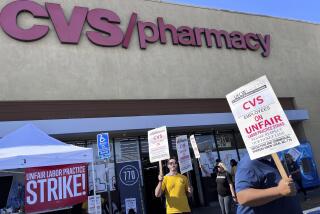For Some Stores, It’s the Great Pumpkin
- Share via
California’s supermarket strike may have squashed hopes for a robust Halloween season at the region’s three largest grocers, but independent markets and corner lots -- as well as their suppliers -- are finding a bumper crop of buyers for their stash of pumpkins.
With Halloween just days away, Southland shoppers unwilling to push past pickets are picking up their future jack-o’-lanterns at outlets such as Trader Joe’s or from merchants such as Bill Derentz, president of Laguna Hills-based Pumpkin City’s Pumpkin Farm & Christmas Trees.
For the record:
12:00 a.m. Dec. 6, 2003 FOR THE RECORD
Los Angeles Times Saturday December 06, 2003 Home Edition Main News Part A Page 2 National Desk 1 inches; 41 words Type of Material: Correction
Supermarket strike -- In its coverage of the supermarket strike and lockout that began Oct. 11, The Times has said repeatedly that the labor dispute affected 859 union grocery stores in Southern and Central California. In fact, 852 stores are affected.
Derentz, who sells pumpkins at his harvest festivals in Southern California, said that normally at this time of year there are at least three dozen pumpkin bins outside of the Albertson’s where he shops in Orange County. Each bin, he said, usually holds about 600 pounds of pumpkins.
But when he checked recently, there was none.
That’s why people are “looking to the pumpkin lots,” Derentz said.
Albertsons Inc. did not return calls for this article. The supermarket chain -- along with Safeway Inc.’s Vons and Pavilions and Kroger Co.’s Ralphs -- has been struggling to maintain business since the United Food and Commercial Workers union launched a strike Oct. 11 after the two sides failed to reach agreement on health benefits and other issues.
The labor strife has affected 859 stores in Southern and Central California.
Although pumpkins aren’t big profit drivers for supermarkets, grocers often offer the large, pulpy gourds as a convenience to customers.
Demand for pumpkins in California and across the U.S. has grown in the last 30 years as harvest festivals and supermarket chains have stretched Halloween from a single night into a weeks-long celebration.
Ralphs doesn’t want to lose all of its Halloween business to independents. On Sunday, the chain began a promotion to lure customers back with the promise of a free pumpkin for those with a coupon and $5 purchase.
“We’re seeing more customers beginning to cross the picket lines and we expect this ad to encourage even more customers to come back and shop with us,” Ralphs spokesman Terry O’Neil said.
Last year, overall pumpkin sales in the U.S. were estimated at $150 million by the U.S. Department of Agriculture.
Derentz thinks that the supermarket strike will boost his pumpkin sales this year by as much as 5% from last year, with much of the buying expected this week. Derentz doesn’t charge admission fees for his harvest festivals, but a pumpkin can cost more than $8, depending on the size, a festival manager said.
“Most of the people who buy at the supermarket don’t buy early,” Derentz said, noting that they usually pick up a pumpkin while buying groceries. “Those are the people who will be coming to us.”
They also, apparently, will be flocking to stores such as Trader Joe’s and Colton-based Stater Bros. Markets, which also has seen a strike-induced bump in pumpkin purchases.
“Our sales are up significantly in about half of our stores,” said Susan Atkinson, a spokeswoman for Stater Bros., which operates about 160 outlets in the region.
Ryan VanGroningen, of VanGroningen & Sons near Stockton, supplies pumpkins to Trader Joe’s and Wal-Mart Stores Inc. And he estimates his pumpkin sales will be up 50% because of the strike.
Ralphs’ O’Neil seemed optimistic that the offer of free pumpkins -- and other free produce including lettuce -- would lure more consumers into stores. He said, however, there was a plan B if that doesn’t happen.
O’Neil said that like other unsold produce, any pumpkin past its prime is trucked back up north -- where it is eventually turned into compost.
More to Read
Inside the business of entertainment
The Wide Shot brings you news, analysis and insights on everything from streaming wars to production — and what it all means for the future.
You may occasionally receive promotional content from the Los Angeles Times.










